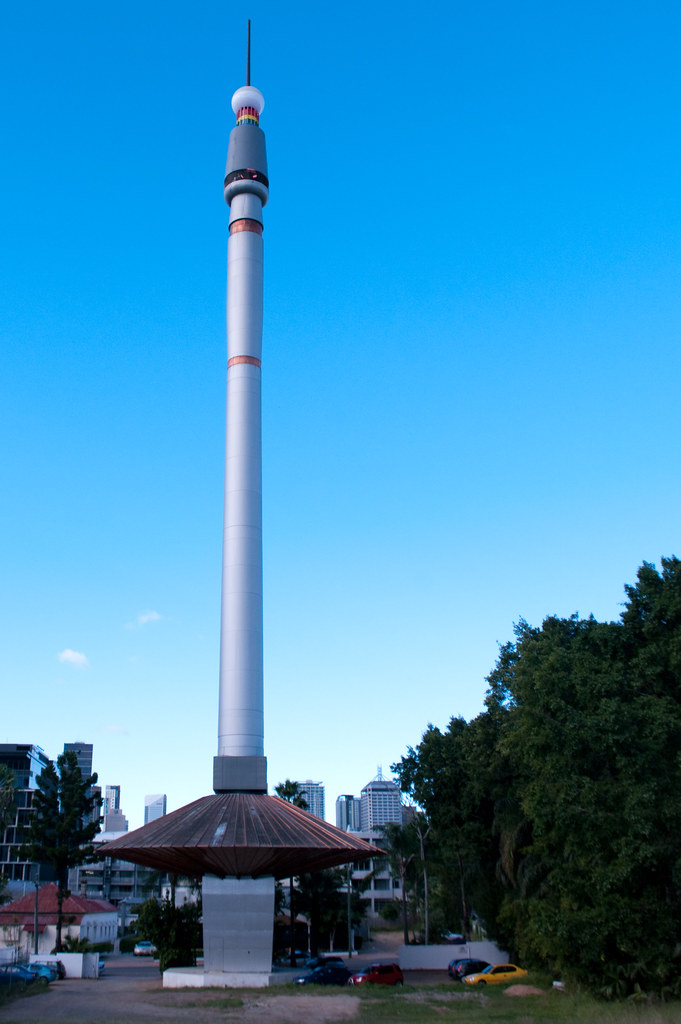I suppose this is something of a Part 3 addendum to the recent Southern Swing articles although maybe it’s not truly the case. Perhaps it would be better to call it “inspired” by those earlier articles. We broke the return trip into a two-day event with an overnight stay in Knoxville, Tennessee. The hotel happened to be located near the Sunsphere, a tower designed for the 1982 World’s Fair.
That was a happy coincidence although unintentional. We never saw the tower during daylight because there’s a lot of darkness near the northern hemisphere’s winter solstice. That’s why I couldn’t get a decent photograph although I still gave it a shot. The sight also made me wonder about other towers built for World Fairs in general. Some of them became iconic structures while others fell into relative obscurity.
Sunsphere (1982) – Knoxville, Tennessee, USA

The Sunsphere that we saw in Knoxville seemed to fall amongst those that didn’t quite capture much public imagination (map); “It represents the sun, source of energy, and reflected the energy theme of the fair.” I guess that wasn’t inspirational enough. It looked like a giant Van der Graaf generator. I guarantee it would have become iconic if it actually shot giant bolts of lightning. Sadly, it did not.
During the fair the Sunsphere featured five primary levels, an observation deck, a kitchen, two dining levels, and a cocktail lounge. It’s had a hard life since the fair ended, standing either vacant or underused for three decades and counting. However, it’s available for rent should someone want to use it for a wedding reception, a corporate event, or a 12MC reader happy hour.
As an aside, I wasn’t aware that the World’s Fair was still a thing. Apparently those events still exist and one will be held in Milan in 2015. None have occurred in the United States since 1984 and that’s probably why I though EPCOT or something must have replaced them by now.
La Tour Eiffel (1889) – Paris, France

I had no idea that the Eiffel Tower in Paris was a remnant of a World’s Fair (map). It served as the centerpiece of the Exposition Universelle of 1889 which also commemorated the 100th anniversary of the French Revolution. The tower that Gustave Eiffel erected brought strong negative reactions from critics at the time and it became a beloved symbol despite their pronouncements. Twelve Mile Circle doesn’t need to mention anything else about the Eiffel Tower, right?
It would be many years before another World’s Fair would attempt to feature a tower. How could any other city top such an iconic structure?
Atomium (1958) – Brussels, Belgium

Neighboring Belgium made an honest attempt in 1958 with its Atomium for the Brussels World’s Fair (Brusselse Wereldtentoonstelling / Exposition Universelle et Internationale de Bruxelles) (map). This was the height of the atomic age. An oddly shiny building with 9 interconnected spheres climbing 102 metres and fashioned in the form of an iron atom enlarged 165 billion times seemed to be an optimal choice for the times. The Atomium can still be visited today and its website describes it as,
“A seminal totem in the Brussels skyline; neither tower, nor pyramid, a little bit cubic, a little bit spherical, half-way between sculpture and architecture, a relic of the past with a determinedly futuristic look, museum and exhibition centre; the Atomium is, at once, an object, a place, a space, a Utopia and the only symbol of its kind in the world, which eludes any kind of classification.”
I agree.
Space Needle (1962) – Seattle, Washington, USA

Seattle’s Space Needle (map) didn’t quite hit the same iconic status as the Eiffel Tower although it probably came closer than any of the other examples. Certainly, many people far beyond the Pacific Northwest would recognize it instantly. Fashions had begun to transition from the atomic age into the space age and the Seattle World’s Fair reflected those changing times.
Tower of the Americas (1968) – San Antonio, Texas, USA

I’ve been to the top of the Tower of the Americas. San Antonio’s convention center is located next to HemisFair Park where the tower was built (map). I went to San Antonio a few years ago for a conference and I had a little extra time so I rode to the top.
This World’s Fair featured “The Confluence of Civilizations in the Americas” as its theme. I’m not sure how the tower reflected that concept although it’s still impressive. The fair commemorated the 250th anniversary of San Antonio and supposedly the theme also referenced several nations that held sway of Texas territory. Some might say 6 Flags Over Texas, other might claim 7 Flags, or whatever.
The Skyneedle (1988) – Brisbane, Australia

The weirdest World’s Fair tower might have been the Skyneedle in Brisbane (map). It reached 88 metres in symmetry with the fair’s title: World Expo 88. However the tower did not accommodate visitors. It was too small. Instead it shot a beam of light around the city.
The Skyneedle was supposed to be relocated to Tokyo Disneyland once the fair closed. Instead, it became the possession of a local hairdresser entrepreneur, Stefan, who moved it to his headquarters nearby. Yelp had a number of amusing reviews:
“Standing tall, proud and pointless Brisbane’s Skyneedle is capable of the occasional light show and little else. Even its powerful beam is only allowed to be used on special occasions as it is a potential risk to plane’s coming in to land at Brisbane airport. But despite its inherent absurdity, or more correctly, because of its inherent absurdity Stefan’s Needle has become a much loved part of the city skyline.”
Pity the Skyneedle.

Leave a Reply